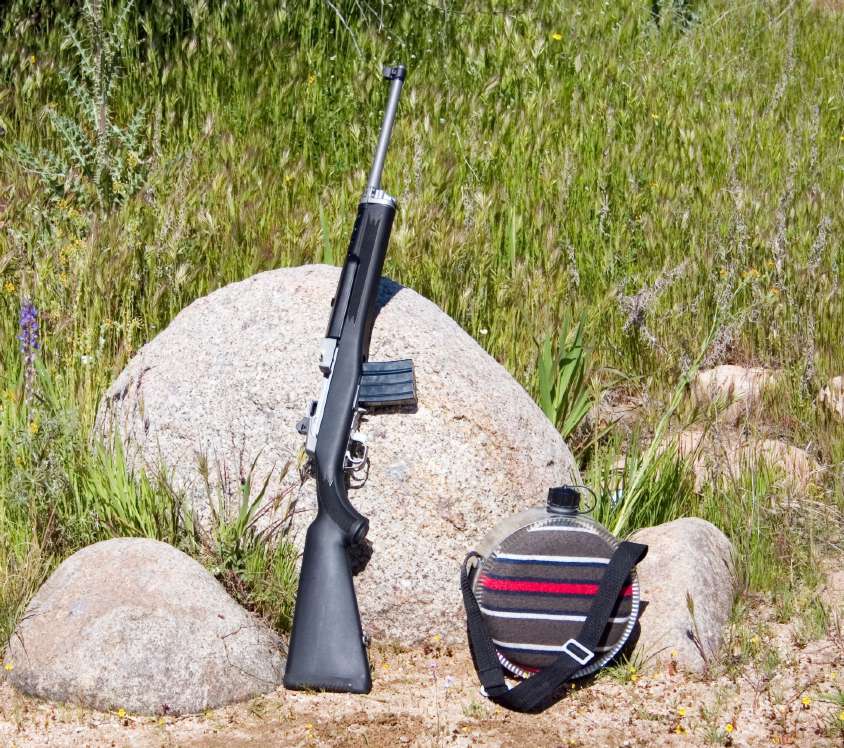Ruger's Mini-14 Ranch Rifle
(.223 Remington)
Since the November 2008 elections, thinly populated gun racks
have been a fact of life in gun shops all over the country.
These days, semi-automatic rifles can be especially hard to
find. Anything that can even possibly be classed as an
"assault weapon" seems to spend very little time on
the shelves of gun shops, often disappearing within mere hours
of being put on display. Consequently, that area of my wish
list was laid aside as probably unattainable for the
present and time marched on.
One thing about my gun collection though is that it's never static
for very long. About three months after the election, the itch
began again. For three or four weeks prior to my purchase, I
had been feeling a desire to get one of the future outlaws
into my gun safe before Congress got a mind to start trying to
pass some silly law that might well destroy an entire segment of
the arms industry in America. About two weeks after the
election, seeing what was happening in the gun shops, I
decided that if I ever wanted an M4 (a purchase I had been
considering all through the previous summer), I needed to get
my name on the waiting list sooner rather than later. More
than four months have now passed and that rifle has yet to
arrive. Based on what I
learned about a week after I filed that order regarding that
specific manufacturer's backlong, I anticipate that it will be
perhaps two months longer before it comes in, if it does at
all.
Further down on my wish list was also the procurement of a
Ruger Mini-14. I had been considering this rifle for a while
because of the rifle's ancestry but was partly attracted to it
by the price, well under what most ARs and M4s run, including
the particular rifle I signed my name for. However, with
manufacturers quoting lead
times measured not in weeks but instead in months – and
double digits at that – it didn't occur to me that
someone might actually have one of these guys until my
friend, Adam, picked one up from Cabella's one Thursday evening.
That Friday, sensing an opportunity to grab something at a
reasonable price, I checked my bank balance and called a few
shops to see what was in stock. As luck would have it, I
located not one, but three shops having one or more. I was
right that these were not spending a lot of time on the
shelves. Cabella's had three others at the time I called but
when I got there the next day (only about 12 hours later),
they had just one left and it wasn't the variety I was looking
for. One of the others was a well worn 186 series (refering to
the three digit prefix of the serial number) and, while it had
a good price, didn't seem to be a good first choice. So off I
went to the last shop on my list. Fortunately, I had
the foresight to ask them to hold this one for me before I
ever left home to begin with.
On arriving at the shop, out came a Ruger K Mini-14/20P wearing a
matte stainless steel finish and sporting a black all-weather
synthetic stock. This rifle was of the new 586 series
and, judging by the serial number, was made this very year. It
didn't take long to decide that I was going to be quite
satisfied with this rifle. My preference is for wood stocks
but beggers can't be choosers. Besides, stocks are quite
readily had and easily changed, a distinct advantage of the
Mini-14 over traditional rifles.
| Type: |
Semi-Automatic Rifle |
| Caliber: |
.223 Remington |
| Capacity: |
20 Round Detachable Magazine |
| Barrel Length: |
18 1/2 in. |
| Overall Length: |
37 1/2 in. |
| Barrel Twist: |
1:9 RH |
| Weight: |
6.75 lbs. |
| Sights: |
Blade Front, Adjustable Ghost Ring Rear |
| Finish: |
Matte Stainless |
| Stock: |
Black Synthetic |
| MSRP: |
$938 |
There was just one hitch... they couldn't find the box. Oh
well, it happens. Doesn't matter much to me anyway since there
wasn't much in it. This one came with only the one magazine, a
lock, scope rings, and a sight adjusting wrench. The only
thing I'll miss is the adjusting wrench. In trade for the
missing parts, they allowed me to select an appropriately
sized soft case and considered it a net/net trade. Fine by
me.
After completing the necessary formalities and exchanging
the requisite quantity of currency (that's always the hard
part), I was headed home to give this rifle a thorough going
over and a good scrub. The fact that the manufacturer's
instruction booklet was missing was no big deal. Ruger
supplies all their documentation online and it was a
relatively easy task to print that out. Besides, this action
is very familiar to me. What could the booklet possibly
contain that I didn't already know?
Dissassembly was simple enough. The mechanism was designed
after that employed in the M1 Garand rifle which was itself
carried over into the Mini's big brother, the M14 though
changed to a short stroke and a metered volume of gas. That
meant seperating the rifle into the three principle groups was a
cinch. Further disassembly was a little trickier, although
easier than in the M1. At least it was until I realized that I
couldn't get the bolt out until after I removed the bolt stop
assembly (See? The booklet was good for something),
although I will admit that removing and replacing the
operating rod spring without damaging it requires some
dexterity.
Satisfied that I knew where everything went, I reassembled it
and set out to buy a quantity of random boxes of ammunition to
use during break in and testing. Since ammunition in almost
any form save for hunting rounds can itself be hard to find,
this task was going to take a while. That gave me plenty of
time to sit down and consider the history of the Mini-14.
Development
There can be no question that Bill Ruger had a nack for
sensing where he could enter a new market and usually when.
As I'm given to understand, the Mini-14 spawned from
an idea he had sometime in '67. He felt that a smaller version
of the then standard issue M14 chambered for the lighter,
easier to handle .223 Remington cartridge would make an
excellent saddle gun or defensive arm for the camper,
outdoorsman, or security personell. He assigned Jim Sullivan,
who had actually participated in the design of the M14, to see
if he couldn't make such a rifle, specifying certain design
changes he felt would be beneficial. It is worth mentioning
that after his departure from Ruger a few years later, Jim
went on to assist in the development of several Armalite
weapons, including the M16, and also designed the Ultimax
100. There is no doubt that Jim was an excellent choice for
this project. Yet due credit must also be given to Harry
Seifried and Roy Melcher for their contributions to the
evolution of the Mini-14.

The author with his Mini-14 Ranch Rifle
Well, Jim set to work. However, because of the new caliber and
smaller size, certain things that were necessary to satisfy
Ruger's requirements as well as keeping the weapon functional,
it could not just simply be a
scaled down M14 internally, it was going to take some
work. After coming up with a design he was satisfied with, he
sent inlet drawings to Lee Brownell to furnish a suitable
stock. As is typical with any mechanical device, it took a bit
of trial and error to get everything just right, including one
amusing incident with Bill happening by while Jim was firing
the prototype which he recounted to R. L. Wilson while Wilson
was preparing his book
Ruger & His Guns. If you happen
to come across this text, it's a story worth looking at.
Part of the protyping process was development of the AC556 by
Harry Sefried, a fully automatic version intended for military
and police use which also contained a selector to change fire
modes to the then novel three shot burst.
Even after the rifle at last entered the catalogue in 1975,
having been sold to law enforcement and government agencies
since 1972, the design still underwent slight revision but
sales were good. Over the first few years, in addition to
sales to the public, Wilson documents specially marked rifles
for three specific Highway Patrol agencies, including the
Arizona Highway Patrol, a sample of which I most definitely
want to add to my collection, being an Arizona native,
totaling 2,276. Further, the AC556 is listed as chalking up
3,500 units, mostly for the French National Police. Wilson
indicates that these numbers are highlights only.
Bill Ruger stated to Wilson and others that if he had been
able to bring the Mini-14 to market five years earlier, he
believed it would have become the standard Army rifle. An
interesting notion, but I'm not sure I agree. A
problem with this statement, I think, is given later on in
that same quote, referencing the M14: "The Army was
looking for a full-power fully automatic handheld weapon. They
really wanted it to do everthing, which it just couldn't
do. They didn't see that." In that era, it is probable
that they would have looked favorably on the Mini-14 as a
weapon better suited to the average soldier than the M14
which, as indicated, was a weapon designed to replace several
other arms commonly carried by a given unit, but I am doubtful
of the perception that it would have been the standard Army
rifle. The Brass just weren't that foresighted, in my
oppinion. Remember, they were far more interested in replacing
a vast array of different small arms with something that would
be more universal. They had different priorities and
consequently were probably not looking beyond that objective.
Distractions
During this period, Ruger found his company defending itself
against an ever increasing number of product liability suits
primarily over their single action revolvers. In the case
of Sturm Ruger & Co. v. Day (Alaska) a court
ordered the company to
pay $2.9 million in punitive damages. In Ruger's annual report
for 1975, the company reported revenues of $33.8
million. The awarded judgement, therefore, amounted to 8.5% of
total revenue for the company. Bill Ruger was left dumbfounded
at the amount of the judgement, not to mention the verdict
itself.
In many cases, the introduction of the transfer bar
safety mechanism was portrayed by plaintiff's lawyers not as a
way to make a good gun that much better but instead, they
argued that this innovation represented an
admission by Sturm Ruger that the old model revolvers were
considered defective.
The Day case was later remanded back to the lower courts by
the Alaska State Supreme Court for a partial new trial with
instructions that any award be limited to $250,000 but the
damage had been done. The complaint and more particularly the
verdict opened the flood gates for litigation. In 1980, the
company found itself defending against somewhere near 60
liability suits. I cannot immagine Bill Ruger's frustration at
this fact.
To understand just what a drain this sort of
thing can be on a company, consider, if all these cases went
to trial and you were required to be
present in court just two days for each of these cases with one
additional day taken for your deposition, you will spend
litterally half the year sitting in a court room or a lawyer's
office. If your principle design team is required to accompany
you as witnesses, you won't be getting much work done that
year. Now suppose this occured five years running and you begin to
get a sense of how irritating this can become.
Wilson states that the number of suits began to decline shortly
thereafter as the company, with a few exceptions, was found to
be not at fault in case after case. I do not know what the
trend has been for Ruger in recent years but judging from the
political winds and the trend in other industries, it can't be
a pretty topic.
This wave of lawsuits was not confined to Ruger or to just the
firearms industry but was across industry as a whole and
liability suits are a major point of discussion among
companies to this day with repeated calls for tort reform and
other corrective measures going ignored within the halls of
Congress.
The Ranch Rifle
Yet somehow in the midst of all this, Ruger continued to
innovate and introduce new products. The Mini-14 had been a
tremendous success. (At one point, Ruger reportedly had an
entire plant devoted to the production of this one
weapon.) While the Ranch Rifle began as a project to satisfy a
request by the French police, ultimately it resulted in
a more sporterized Mini-14. This version included integrated scope
bases but incorporated flip-up iron sights along with alterations
necessary to reduce the impact of the operating rod on the
receiver which had a nasty tendancy to trash scopes.
Like its sibling, the Ranch Rifle also became widely popular
and continued to be sold pretty much unchanged for the next 20
years. One of the reasons for the popularity of this rifle was
its considerable versatility. After market magazines, stocks,
flash hiders, bullpup kits, and even .22LR conversion kits
abounded. Indeed, to change the Mini-14 from a rough 'n ready
saddle carbine to a tactical rifle required little more than
seating a flash hider onto the end of the barrel with a set
screw (which would unfortunately leave a dimple on the
barrel), changing to a tactical stock, and changing out the
compact and unobtrusive 5 round magazine to a 20, 30, or even
40 rounder.
The Mini was not perfect, however. The original rear sight was
deemed somewhat flimsy by many and too readily suffered damage
in less than ideal conditions. Due to politics, in many states,
magazines with a capacity larger than 5 rounds were made
illegal. This combined with the fallout from the liability
suits kept Ruger from offering them directly except to law
enforcement for years, opening the market up for the after
market add-ons but many of these failed to function properly,
either not seating easily or correctly every time and often
exhibiting feeding problems.
Another common problem with the Mini-14 is shell ejection. In
order to make the gas system reliable, more tolerant of
variances in ammunition, and better resistant to fouling, the
factory installed bushing on the gas port was made generously
large. I have seen specs that have this averaging about 80
thousandths. This is all fine and well until you go to
retrieve your spent cartridges and can't find
them because they got sent off into the wild blue yonder. Not
to mention irritating shooters around you as they get pelted
with hot, high-velocity brass.
To reduce this problem many have
chosen to fit a smaller bushing to decrease the gas port
opening to as small as 40 thounsandths and thereby reducing
the force with which the piston recoils and thus the force
with which the brass is ejected. Installation of this component
also has the side effect of reducing the powder residue that
ends up around the piston. But there's a cost to making this
alteration. Reducing the opening too small means the action
may not cycle reliably, especially with lesser quality
ammunition. It also means that powder fouling or
lack of lubircation may result in jams, stovepipes, and other
failures. Perusing the various
forums suggests that most who have gone this route do not recommend
this opening be reduced below 50 thousandths if at all.
At this point, I should take a moment to emphasize that this
is not a kitchen table project since even removing the gas
block assembly can be difficult (in fact, Ruger recommends
strongly that it never be done) and proper alignment,
applying the right torque to the screws, as well
as locking them in by some method afterwards is critical to
the safe and reliable operation of the rifle.
Perhaps the biggest complaint about the Mini-14 was about the
accuracy. This rifle was never designed to be a super accurate
competition rifle and as such often only held to 3, 4, or even
5 minutes of arc. Naturally, this caused some consternation
when law officers could not qualify at 100 yards with their
rifles because of the innacuracy inherent in the rifle
itself. These problems never escaped the notice of the company
but proved difficult to overcome.
So in 2005 the Mini got a rework. Manufacturing methods were
updated, machines and fixtures improved, a more traditional
ghost ring aperture rear sight was substituted and protective
ears for the front blade which made the whole setup reminiscent of that
found on the M14 and M1, a different system used to fix the
front sight to the barrel, and an improved gas block and
fitting system were added. New
models also seem to have a more substantial barrel which ought
to serve to better deal with long strings of fire. These
changes have improved the accuracy of the Mini to perhaps 2 to 3
MOA out of the box. But if that's not good enough for you, they
also have a target model with a heavier barrel, recessed
crown, and adjustable harmonic damper (read,
"weight") to further refine the spread. The Target
Mini is about $150 more than the standard rifles but is
perfectly capable of sub-MOA accuracy without a trip to the
gunsmith.

Here, my cousin and sometimes photographer, Corwin takes a moment to pose for the camera.
A day out in the desert is far more fun with company.
Ruger's 2009 catalogue lists 14 different ordering options for
the Mini, including the 6.8 SPC chambering and the Mini-30,
7.62 x 39mm rifle, with prices ranging from $855 for the basic
Ranch Rifle up to $1,082 for the Target Rifle. One of these
variants is even supplied with an ATI 6 position telescoping
stock with a weaver rail over the hand guard. Shooters who
love the Mini will no doubt greatly appreciate the improved accuracy
but one of the features to get more note than some might think
it deserves is the fact that these rifles are now factory
supplied with 20 round magazines where legal to do so instead
of the standard 5 rounds. Of course, that may change
depending on what our Congress critters do but for now, I'm
quite happy about it.
After carefully inspecting my Mini, I was pretty pleased with
the design and the way everything fit together. There was one
aspect of the construction which I found particularly
interesting. Ruger casts as many parts as they can and this
includes the operating rod. But
even though this part is obviously a single casting, there are
weldments on either side of the joint between the charging
handle and the piston and, curiously, these TIG welds also
appear to have been done by hand. I assume these welds are
intended as reinforcement since this section of the rod
endures the most stress during recoil. The question I can't
answer is why they're necessary vs just casting additional
material onto the rod. Presumably this was done either as a
repair for a cracked casting (since castings with small areas
are very hard to do) or the material they deposited during welding is
metalurgically supperior to the rest of the casting. The welds look
very good so I have no
doubt at all that the part is sound, I just find it intriguing
that this was done.
For myself, while the ghost ring and blade is traditional,
I've never considered it to be a very good sight. I'd be much
happier with a low profile peep sight, V-notch, or even a
semi-buckhorn rear sight and may consider such an
alteration later on. As indicated earlier, that's one of the
beauties of this rifle, that there are so many after market
add-ons that you can pretty well change the look and feel to
whatever suits you.
One other thing I do lament about the new design is that
the front sight is now placed all the way at the front of the
barrel. This means that it is no longer possible to attach a
flash hider or muzzle brake in the same manner as it was in
the past. If you want
a suppressor on your Mini now, you must remove the front sight
entirely (which does not appear to be an easy job) and utilize
a compenent intended to replace this sight or purchase the
tactical version that Ruger includes in their catalogue. It is
also my understanding that the suppressor on the tactical
rifle is not a removable component if you decide you do not
wish to have it mounted all the time. The other alternative is
to have a gunsmith cut threads into the end of your rifle's
muzzle.
Let's Do The Twist
An issue that seems more prevelant with .223 chambered rifles
than any other is the barrel twist rate. Today, most ARs have a 1:7 or
1:9 twist, perhaps favoring the latter. This is up from the
earlier 1:12 and even 1:14 from some of the earliest
productions. The Mini-14 likewise changed over time, going
from the original 1:10 twist to 1:7 in 1988 and finaly to the
present 1:9 in 1994.
So what does that mean? Well, generally, it isn't going to
mean a whole heck of a lot to someone using this rifle for recreational
shooting or just plinking. To those who wish to use this for
picking off varmits and coyotes or more regulated target
shooting, it could mean quite a bit.
In fine, there is a correct rate of twist for a given length
and weight of bullet and length of barrel with bullet length
being the factor given the most attention. The longer (heavier)
the bullet, the faster it needs to spin. Spin a bullet too
slowly and you won't generate enough gyroscopic force to
stabalize it. If you spin it too fast—what some folks
incorrectly term as "over stabilized", a bullet is
either stable or it isn't—and the nose may not
cant downward to match the drop of the bullet on a far target
resulting in increased wind resistance, a slightly off-angle
impact, and poor penetration. You also trade forward velocity
for rotational energy, reducing impact force. In the extreme,
if you spin it faster still you can litterally tear the jacket
off or disintegrate the bullet entirely before it ever gets
near the target.
What all that says is that the accuracy of any rifle depends
on matching the bullet to the barrel. In most hunting rifles,
this is not a problem since there may well be only one or two
twist rates out there for a given chambering and that may be,
say, 1:12 and 1:14, and since these are close enough to each
other, what will work in one will generally work in the
other. The .223, on the other hand, has a very wide
variance. Bullet weights also vary widely. Some rounds are as light as 40
grains and some as heavy as 80 grains or even heavier. That
represents a 100% increase in bullet mass. It
should be obvious that these weights will perform differently
in different rifles. Putting a 40 grain round into a 1:7
barrel will probably not be a good idea. Equally, putting an
80 grain bullet into a 1:14 barrel will also be
disappointing.
Even in the .223 chambered bolt action hunting rifles, twist rates
vary. Ruger and Kimber seem to use 1:9 for all their rifles while
Remington's 700 uses 1:12 and Savage uses both 1:9 and 1:7. So
knowing what you have becomes pretty important. Most random
boxes of ammunition you are likely to pull off the shelf will
probably be 55 grain. This weight/length should be a
reasonable compromise for most rifles.
Performance
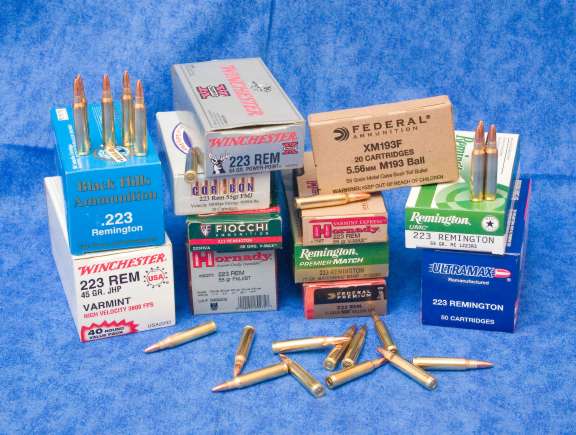
A great variety of .223 may be found on the market.
When I made my decision to purchase my Mini, I was well aware
of the reputation for innacuracy the older versions had. To
try to eek as much out of this as I could, I opted for a nice,
slow, methodical break in. Taking with me 40 rounds I had on
hand and purchasing from the range another 20, I set to
work. 3 shots followed by a snake and two passes through the
barrel with a KleenBore® soaked patch with at least a 5
minute cool down after every 10-15 rounds until I reached 30
rounds. From then, 5 round groups until I hit 60 with barrel
treatment every 10 rounds, the whole time being certain to
keep the barrel from becoming too hot to hold.
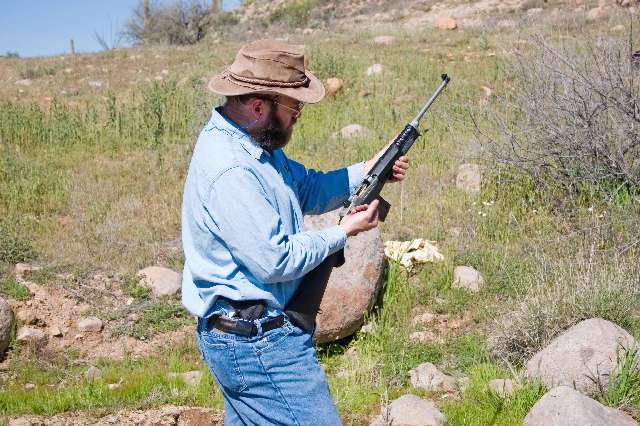
Getting down to business.
Because of the multitude of twist rates available for .223
rifles, I had an interest in trying this rifle with as many
different loads as I could get my hands on (and my remaining
bank account would permit.) By the time I was finaly ready to
head down to the range for my performance tests, I had
procured twelve commercial loadings ranging in weight from 45
up to 77 grains. With the 1:9 twist used on this rifle, I did
not excpect any of the bullets to simply disappear on me but I
did expect substantial differences in the patterns and a notable
spread in velocities.
A problem I was not prepared for was for my day at the range
to end up being two days. It took about 10 minutes for me to
figure out that I was not going to be able to get decent
results out at 100 yards using the iron sights. Afterall,
these are combat sights and not intended for precision
work. To make things reasonable, I determined that I would
have to borrow the Simons ProSport scope off my 77/22 in order
to give me a reliable point of aim. Of course that made me
miss the scope rings since the ones on the 77/22 aren't quite
high enough for me to be willing to use them with this scope
on this rifle. It did not appear that the objective lense
actually touched the hand guard but the lense cover would
deffinitely not fit over it and that's just too close for
me. It frankly annoys me that scope rings are so costly
considering what they consist of.
|
Winchester JHP
|
45 | 3311 | 33.3 | 974 | 2.5 |
|
Fiocchi V-Max FMJ
|
50 | 3258 | 43.1 | 1107 | 2.8 |
Federal XM193F
M193 Ball
|
55 | 3289 | 42.3 | 1321 | 3.8 |
|
Federal Premium V-Shock JHP
|
55 | 3017 | 39.4 | 1111 | 4.5 |
|
Corbon FMJ
|
55 | 3131 | 29.6 | 1197 | 3.8 |
|
Hornady V-MAX
|
55 | 2996 | 22.0 | 996 | 2.2 |
|
Black Hills SPT
|
60 | 2934 | 38.1 | 1147 | 3.3 |
|
Winchester PPT
|
64 | 2825 | 41.7 | 1134 | 3.4 |
|
Ultramax JHP
|
68 | 2682 | 23.7 | 1237 | 3.6 |
|
Remington Premier Match
|
77 | 2596 | 17.4 | 1152 | 3.1 |
Groups were best of two 5 shot patterns at 100 yards
from a sandbag rest.
Velocity measurements were the average of 5 rounds at 15
feet from the rifle's muzzle and were taken separately.
|
As you can see, there most deffinitely was a notable spread in
velocities, looking at the 55 grain bullets specifically, but
it wasn't as broad as I expected. What interested me more was
the overall spread in energy delivered to the target, ranging
from the "measly" 974 ft-lbs for the 45 grain up to 1321
ft-lbs for the M193 Ball rounds. While this is perhaps the
most dramatic difference in muzzle energy I've seen in one of
my tests, I suppose it should not surprise me that the
mil-spec rounds hit harder than even the heavy slugs did.
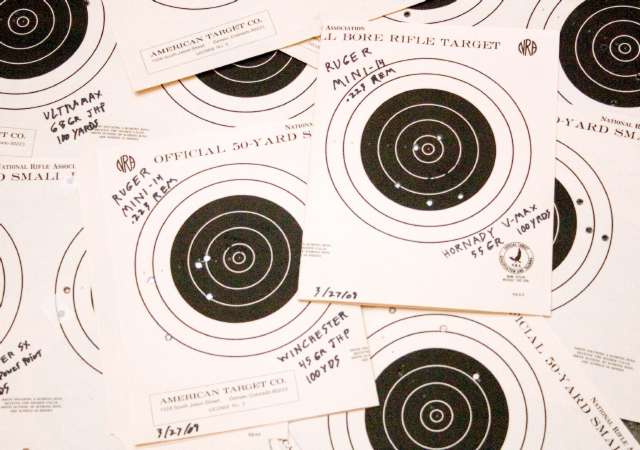
Accuracy has most deffinitely improved with the new Mini-14.
All in all, I was pleased with the results. The groups were
pretty large but if we assume 25% of the size of the
respective patterns was due to the shooter and not the rifle,
that makes the range about 1.7 to 3.4 in. It was a bit
surprising to me to find that the heavier rounds didn't fare
nearly as well as the lighter rounds. Even the 45 grain rounds
from Winchester did better than the match rounds.
So prominent in many performance charts, including mine, is a
column displaying muzzle energy. Those of you who haven't
spent much time shooting probably understand what it says but
may not have a good idea of what it actually means on the
firing line. Well, lets take a closer look at just what 1,100
ft-lbs of force can actually do.
During a recent desert trip with my cousin, I set
a couple of one inch thick steel plates out at about 35
yards. (For the record, this is closer than I would have liked.)
During the day, several weapons were fired at this
plate, ranging from my little 77/22 on up to 7.62x54R from my
Mosin-Nagant 91/30.

Albeit a small caliber, the .223 Remington packs an impressive
punch.
As you might expect, the 7.62x54R left a sizable
crater in the surface of the plate. Likewise, several smears
of lead can be seen from the .22 LR from the 77/22. There are a
couple of larger smears from .45 ACP rounds but the most
interesting are the .44 magnum and the .223. There are three
craters in the center of the plate. In the center of these three
craters is an impact from a .44 magnum round. This round was a
semi-jacketed flat nosed soft point. Yet there was enough
power behind that bullet to ever so slightly dent the steel
by itself. (Not bad for a handgun.) The crater on the right is
from the MN. The two on the left may appear to be from the MN
but I assure you, they are actually from the Mini-14. Yes, the
.223 had enough power to dig a quarter inch deep crater in
solid steel. That's what 1,100 ft-lbs means down range
and that's why the .223 Remington was adopted by the
U.S. military as the standard rifle chambering.
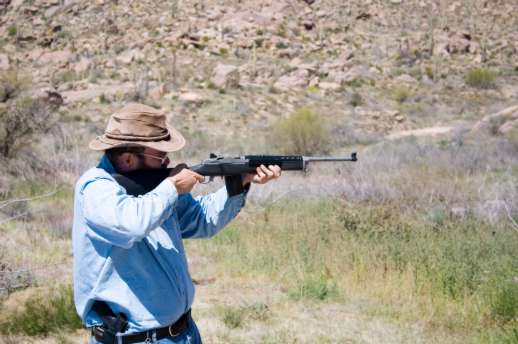
While not hard to tame, the recoil from a .223 can be
surprising to new shooters.
It should be mentioned that my tests were not without their
difficulties. On at least five occassions I had rounds that
the rifle failed to properly extract from the chamber, there
were at least 2 that did not orient correctly during feeding
and ended up with the point of the round stuck off to the size
of the chamber, and on not less than 3 occassions, rounds got
caught in the magazine and did not elevate to the top of the
mouth resulting in the bolt skipping over them and closing on
an empty chamber. All this with the factory magazine, which
was in use throughout the entirety of my tests. Some of these
are pretty obviously magazine related and were probably the
result of grit and grime. The failed extractions are the only
issues that concern me.
Of somewhat more prevelance, I observed that the majority of
the casings collected from my rifle showed damage to the case
mouth. This damage was the result of the casings impacting the
rifle when they were ejected. On
inspection of my rifle during cleaning, it appears that they
are being thrown against the charging handle since there is an
area of speckled brass coloring. The part that I can't figure
out is that this coloring is on the right side of the handle,
on the area facing away from the chamber. It is difficult to
see how a case flying from the chamber, way back over my right
shoulder can impact on the right face of the arm it's being
ejected from. All I can figure is that the bolt is rebounding
fast enough that it is not so much the brass that's hitting the
charging handle, rather, it is the charging handle impacting
the brass. Fixing this will probably require an adjustment to
the ejector but I'll have to puzzle over that one a while and
consider what specific fixes would be necessary.
Extras
An item I was not pleased with was one of the extras I
picked up. When I was at one of the first shops on my list, I
noted that they had some after market magazines for this
rifle. After asking the gentleman at the counter about two I
was interested in, he recommended I take the Triple K 40
rounder so I bought a pair as an investment. While I
was discussing this at the counter, he allowed me to try one
of these in the rifle he had on display. At first, it appeared
to give very positive lock, held the bolt open as it should,
and gave the appearance of good function. But when I brought
it home and tried it in the rifle I purchased, I got a
different impression.
I noted that the magazine seated with some difficulty and that
after being seated and removed two or three times that the lip
above the hole for the latch was bent. After straightening
this, my fix was to slightly ream the hole to raise it a
bit higher and thereby avoid excessive pressure as it was
pressed home. Next problem was that seating the magazine
required a little more force than it should have. Comparing
dimmensions with the factory mag, there was a sharp increase
in width below the mouth (slight, but abrupt) which caused it
to bind. Sanding
this down fixed that but I also found that it was necessary to
round out the corners on the mouth of the magazine. One final
problem was the lug on the back was not flat and projected too
far on one side as a result. This too required light sanding
and smoothing to make the magazine line up and lock into place
with ease.
As is typical with after market magazines, the most serious
problem was feeding. Loading half a dozen rounds and running
them forward with my fingers, I observed that the nose of the
shells had a tendancy to catch on the front lip. Again,
comparison with the factory mag showed the fix for this and I
was able to use my Dremel followed by 1,000 grit
sand paper to carefully make relief cuts to form more of a
ramp for the nose to skip off of if it struck. After working
with this magazine further, I actually question the follower
itself as a contributor to these feeding problems.
While I believe I have resolved the major issues with this
magazine and it now seems to function pretty reliably, I would
not recommend these for purchase unless
Triple K is willing to rework their manufacturing processes to
correct these defects and hold tighter tolerances. But that is
not to say all after market mags are bad. For myself, I'm
pondering getting a pair of ProMag 30 round thermo formed
magazines later on to see how they work out.
Final Thoughts
The Mini seems to be a rifle you either love or you hate, at
least it used to be. With the 2005 update, this rifle seems
notably improved and ready to take whatever is thrown at
it. While the AR and M4 may have replaced it in the arsenals
of law enforcement and security agencies, it remains a rugged,
reliable rifle. The 20 round magazine is a great
improvement over the previously standard 5 round mag. Albeit
somewhat imprecise, I found the sights adequate enough to allow me to
hold 6-8 inch groups at 100 yards and routinely hit the 18 inch
gong at the 300 yard line at my local range. (Unfortunately,
the sound of a strike from a .223 can be hard to discern when
most of the guys around you are firing 7mm and larger.)
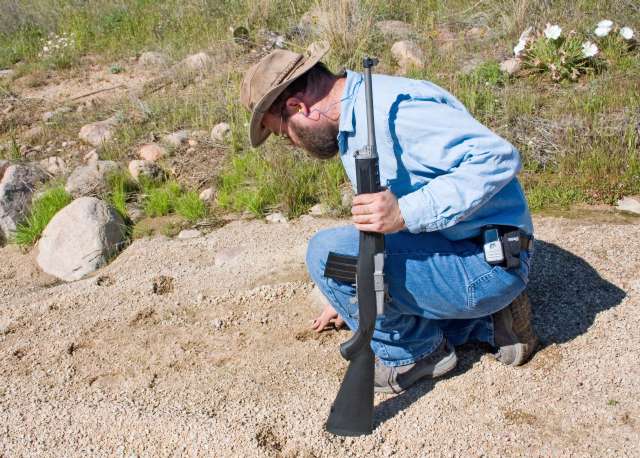
"We're not alone here."
While many have been absorbed into large conglomerates, there
are still a fair number of private ranches in my state. Out in the desert
here around the Phoenix metropolitan area, it's no great feat
to find signs of coyotes and other predators. Even during my
recreational trip out to the desert, I ran across tracks not
more than a few hours old. While many property owners
recognize that these animals too have a place
in the ecosystem, from time to time, they can become a
nuisance and must be dealt with.
The favored method for moving
around in rough territory may be the quad-bike these days but
since some of the territory is quite difficult to access, a
significant number of citizens still prefer saddling up a
horse. In either case, when you're out on your own, it is wise
to have some method of protection. Neither mode of travel
allows room for a big, ungainly weapon. Besides, when you're
gonna need it, you're probably gonna need it in a hurry which
means a light carbine trumps a full sized rifle. Just
as it was originally, the new Mini-14 is still a perfect
candidate to fill that role.
My Mini-14 Ranch Rifle, for the most part, met all expectations
and then some. Accuracy has deffinitely improved in the new model and
while it is still not intended as a long range hunting rifle,
it'll handle the close in work typical of varmints and small
game just fine, not to mention anonymous soup cans,
watermelon, grapefruit, soda bottles, and anything else that
one finds just far too dangerous to leave sitting in the
pantry. If it's small to medium sized and needs a hole in it,
the Mini-14 will do nicely.
|
